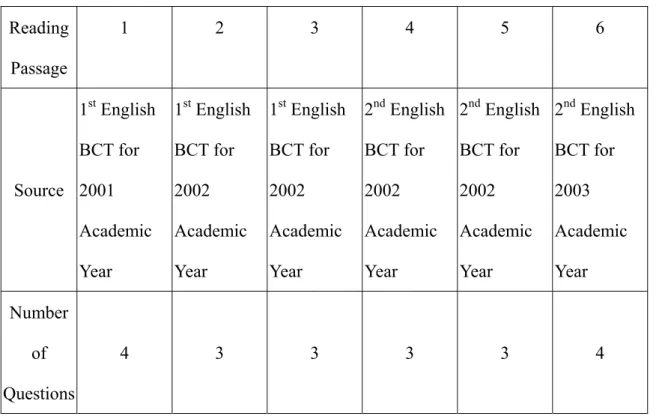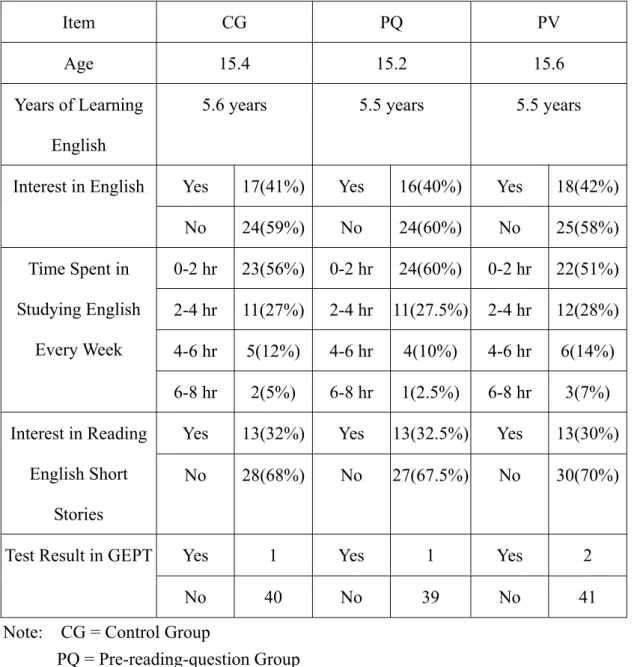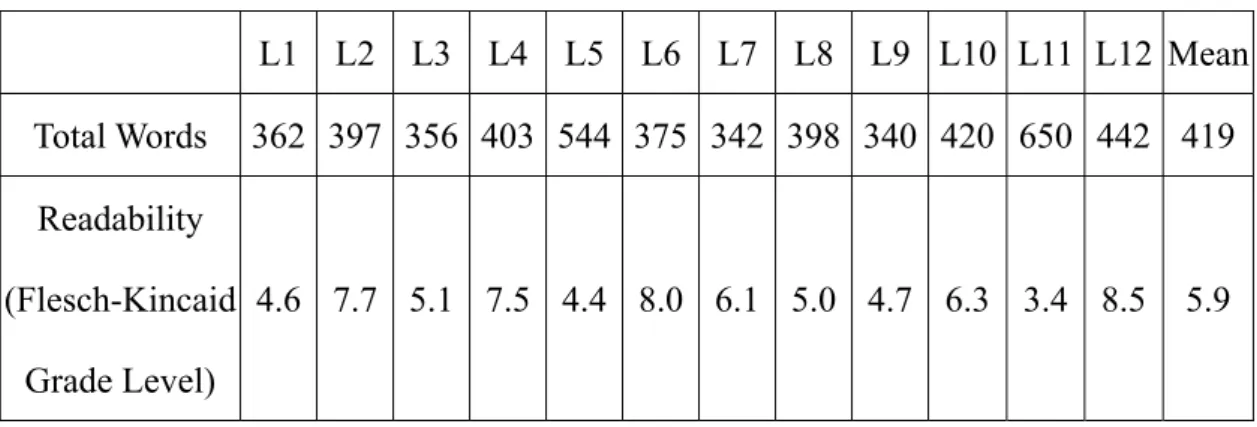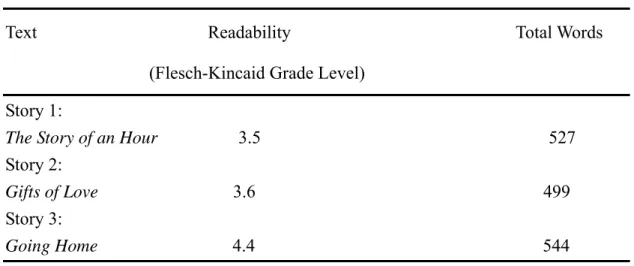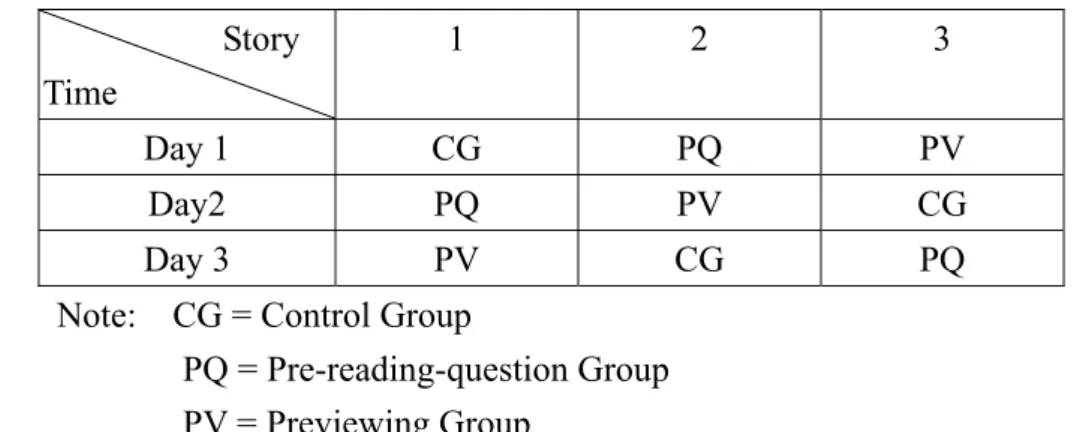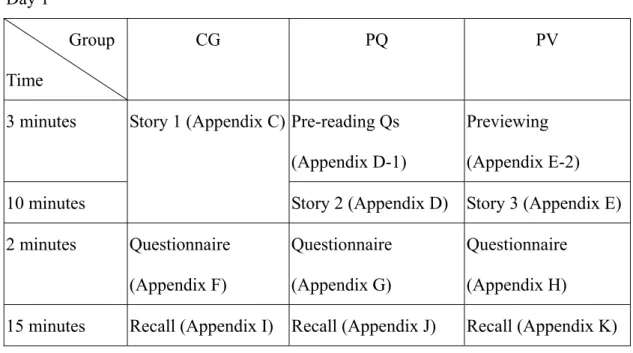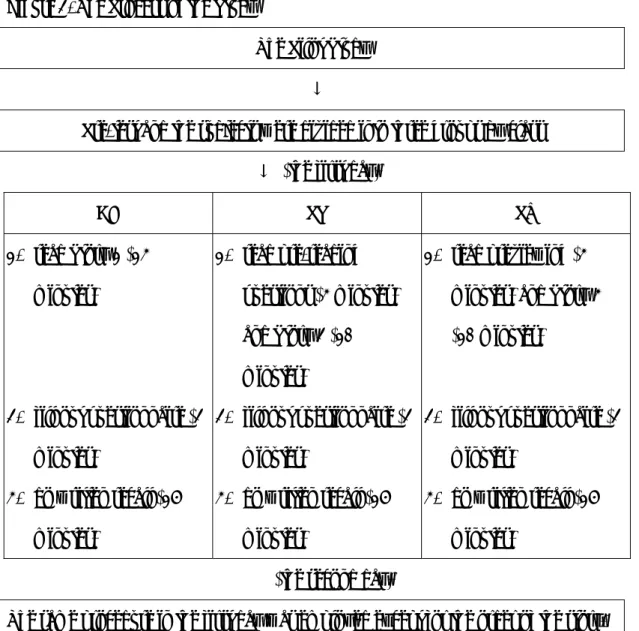CHAPTER THREE METHODOLOGY
The research design of the present study is described in this chapter. There are four major sections in this chapter. The first section is a description of the subjects participating in the study. The second section is about the instruments employed in the study. In the third section, a clear account is given to the procedure undertaken in the study, and finally the statistical measures used to analyze the data in the study conclude this chapter.
Subjects
124 students from three different classes in their first year at a senior high school in Pingtung County participated in this study. The English proficiency of most students was low intermediate and none of them had studied abroad, nor had been to English-speaking countries. All of the students had at least received three-year formal curriculum in English at junior high school and the time they learned English might be longer if the extracurricular courses students received at cram schools were included. The reason why the researcher recruited tenth graders, i.e., the first year students in the senior high school, as the subjects in this present study was that they had just graduated from junior high school, therefore were not supposed to have been exposed to extensive reading. They neither had received much training in reading nor acquired many reading strategies, such as skimming, scanning, metacognition, etc.
Consequently, it would be more valid to evaluate whether their reading performance
was facilitated by the two pre-reading treatments in the study, i.e., pre-reading questions and previewing.
A pre-test was used to check if there existed proficiency difference among the subjects. The pre-test consisted of six reading passages and twenty multiple-choice questions. One passage was excerpted from the first Basic Competency Test (BCT) for the 2001 academic year, another two articles were from the first BCT for the 2002 academic year, still another two were from the second BCT for the 2002 academic year and the other passage was from the second BCT for the 2003 academic year.
One-Way ANOVA was employed to analyze the grades of the subjects and based on the result (F .05 (2, 121) = .220, p = .803 > .05), there were no statistically significant differences in the English proficiency among the students in the three classes. To put it another way, the three groups were considered to be homogeneous in terms of their English proficiency.
These subjects in the three classes were randomly assigned by class to one of the three groups, the Control Group (CG), the Pre-reading-question Group (PQ), and the Previewing Group (PV), with 41 students in CG, 40 students in PQ, and 43 students in PV. The distribution of the subjects in each group is demonstrated in Table 1.
Table 1. The Distribution of the Subjects by Group and Sex
Sex / Group CG PQ PV Male 21 21 21 Female 20 19 22
Total n = 41 n = 40 n = 43 Note: CG = Control Group
PQ = Pre-reading-question Group PV = Previewing Group
Instruments
The instruments used in this study contained a pre-test (see Appendix A), a personal data sheet (Appendix B), three short stories (Story 1 in Appendix C, Story 2 in Appendix D, and Story 3 in Appendix E), three sets of pre-reading questions (see Appendix C-1, D-1, and E-1) for the three short stories for the PQ, three sets of previewing (see Appendix C-2, D-2, and E-2) for the three short stories for the PV, three questionnaires (see Appendix F, G, and H) for CG, PQ, and PV respectively, and three written recall protocols, (see Appendix I, J, and K) for three short stories. The details of each instrument are explained as follows.
Pre-test
The pre-test, including six reading passages with twenty multiple-choice questions (see Appendix A), was employed to measure the subjects’ English reading proficiency. All the reading texts and questions were excerpted from the English Basic Competency Test (BCT). The sources of the six reading passages and the number of the questions asked are listed in Table 2.
There were two reasons why the researcher used the English Basic Competency Test as the pre-test in this present study. First, the English Basic Competency Test is a placement test, which is suitable for grouping the subjects. Second, the English Basic Competency Test is developed mainly for junior high school graduates to test their English reading proficiency; therefore, it suits the 10th graders, who graduated from junior high school not long ago (about half a year), to take the English Basic Competency Test as an index to examine their reading ability in English.
The results of the pre-test are analyzed by one-way ANOVA in order to see if there are any differences among the subjects. The result (F .05 (2, 121) = .220, p = .803
> .05) showed that there are no statistically significant differences in the English
proficiency among the students in the three classes.
Table 2. The Sources of the Six Reading Passages in Pre-test Reading
Passage
1 2 3 4 5 6
Source
1st English BCT for 2001 Academic Year
1st English BCT for 2002 Academic Year
1st English BCT for 2002 Academic Year
2nd English BCT for 2002 Academic Year
2nd English BCT for 2002 Academic Year
2nd English BCT for 2003 Academic Year Number
of Questions
4 3 3 3 3 4
Personal Data Sheet
A sheet of personal data (Appendix B) was employed to understand better of the background of the subjects taking part in the study. The Personal Data Sheet
included the subjects’ name, gender, age, reading habits, as well as some basic questions about their experiences in English learning. The details of the subjects’
background of English learning are shown in Table 3.
Table 3. Subjects’ Background of English Learning
Item CG PQ PV Age 15.4 15.2 15.6 Years of Learning
English
5.6 years 5.5 years 5.5 years
Yes 17(41%) Yes 16(40%) Yes 18(42%)
Interest in English
No 24(59%) No 24(60%) No 25(58%)
0-2 hr 23(56%) 0-2 hr 24(60%) 0-2 hr 22(51%) 2-4 hr 11(27%) 2-4 hr 11(27.5%) 2-4 hr 12(28%) 4-6 hr 5(12%) 4-6 hr 4(10%) 4-6 hr 6(14%) Time Spent in
Studying English Every Week
6-8 hr 2(5%) 6-8 hr 1(2.5%) 6-8 hr 3(7%)
Yes 13(32%) Yes 13(32.5%) Yes 13(30%)
Interest in Reading English Short
Stories
No 28(68%) No 27(67.5%) No 30(70%)
Yes 1 Yes 1 Yes 2 Test Result in GEPT
No 40 No 39 No 41 Note: CG = Control Group
PQ = Pre-reading-question Group PV = Previewing Group
As reflected in Table 3, all of the subjects in the three groups were about fifteen years old and they had learned English for about five and a half years. There were less than half of the subjects in each group interested in studying English (41%, 40%, and 42% for each group) and more than half of the participants spent less than two hours studying English every week (56%, 60%, and 51% for each group). About thirty percent of the subjects were fond of reading English short stories (32%, 32.5%,
and 30% for each group) and one person in CG and PQ, and two people in PV passed the basic level of GEPT, whose proficiency is about that of a junior high school graduate. Generally speaking, the subjects in this study were moderately
uninterested in studying English and did not spend much time on it. Most of them expressed that they did not like reading English short stories and only few of them passed the GEPT. In other words, moderate numbers of the participants were less active learners in English, who were not interested in English learning and did not make many efforts to master English.
Reading Texts
To select proper reading passages for the subjects, the texts that the subjects were now studying, i.e., Book One, published by the Far East Book Company, should be analyzed as a baseline. There are 12 reading texts in the textbook. The number of total words and the readability of each text are shown in Table 4.
Table 4. Features of the 12 Texts in Book One by the Far East Book Company
L1 L2 L3 L4 L5 L6 L7 L8 L9 L10 L11 L12 Mean Total Words 362 397 356 403 544 375 342 398 340 420 650 442 419
Readability (Flesch-Kincaid
Grade Level)
4.6 7.7 5.1 7.5 4.4 8.0 6.1 5.0 4.7 6.3 3.4 8.5 5.9
To choose the three short stories, the results shown in Table 4 were taken into consideration.
Three American short stories were used in this study. The first one, The Story of an Hour (Appendix C) by Kate Chopin, was adapted from All American Stories B
edited by C. G. Draper (2006). In the original text, there were 768 words, which was too long for 10th graders and it might take up too much time to read through the whole story. Owing to the time constraint and the reading abilities of the subjects, the story was revised and shortened to 527 words by the researcher and two of the researcher’s colleagues, who have had over 10 years’ experience in English teaching.
The second story, Gifts of Love (Appendix D) by O. Henry, was extracted from English Textbook 1 for senior high school students published by Far East Book Company in 2002. The original text in English Textbook 1 had 504 words, with the readability of 2.5, which would be too easy for the 10th graders. For the sake of the adequacy of the reading text in the study, Story 2 was rewritten by the researcher and two of the researcher’s colleagues to the readability of 3.6 and 499 words.
The third story, Going Home (Appendix E), was extracted from English
Textbook 3 for senior high school students also published by Far East Book Company in 2003. The original version had 689 words and its readability was 5.3, which, according to the researcher and seven colleagues of the researcher’s, also English teachers, would be too difficult for 10th graders. Hence, in the similar way with the previous two short stories, the researcher and two of the researcher’s colleagues rewrote the third story to the readability of 4.4 and 544 words so that it could be properly used in this study.
To avoid the loss of the originality and coherence of each story, the three stories were checked by a native speaker, who majored in English literature in university and TESL (Teaching English as a Second Language) at graduate school.
The readability and the total words, of the three short stories are specifically addressed in Table 5.
Table 5. Features of the Three Selected Reading Texts
Text Readability Total Words (Flesch-Kincaid Grade Level)
Story 1:
The Story of an Hour 3.5 527 Story 2:
Gifts of Love 3.6 499 Story 3:
Going Home 4.4 544
Although the readability of the three stories was below the mean of that of the twelve lessons in Book One, without the teacher’s instruction and vocabulary glossed in the margin, the difficulty level of the three short stories was increased because the length of the stories was longer than that of articles that the subjects were used to reading in class. In addition, the subjects had to finish reading each story in limited time, which appropriately increased the difficulty level of the task, too.
In order to avoid possible sequence effect, the sequence of the presentation of the three stories for the three groups was counterbalanced. That is to say, for CG, the sequence of the stories is Story 1, Story 3, and Story 2, for PQ, Story 2, Story 1, and Story 3, and for PV, Story 3, Story 2, and Story 1. The sequence of the three stories is shown in Table 6.
Table 6. The Sequence of the Presentation of the Three Stories for the Three Groups Story
Time
1 2 3
Day 1 CG PQ PV
Day2 PQ PV CG
Day 3 PV CG PQ
Note: CG = Control Group
PQ = Pre-reading-question Group PV = Previewing Group
Pre-reading Questions
In this study, pre-reading questions (Appendix C-1, D-1, and E-1) were designed for the three American short stories by the researcher and two of the researcher’s
colleagues. There were three pre-reading questions for each of the three short stories.
The pre-reading questions aimed to bring to mind the subjects’ background knowledge and connect their prior knowledge to the main idea of the reading
selections in the study. Before the subjects in the Pre-reading-question Group read each story, the researcher read the pre-reading questions for the students to make sure that each of them had read them all. After that, they were asked to read them again and tried to answer them by themselves.
Previewing
The researcher and two of the researcher’s colleagues designed previewing passages (Appendix C-2, D-2, and E-2) for the three stories. Previewing, according to the guidelines by Graves, Prenn, & Cooke (1985), begins with a question or a statement to get readers’ attention and interest, then briefly describes the specific information important to the story, introduces the characters, depicts the plot up to the climax, and gives directions for reading the story. The previewing, intended to get
the subjects’ attention on the important parts of the upcoming story, describes the main story lines about the short story and ends before the climax of the story.
In this present study, the previewing, a written script relevant to the topic or content of the about-to-read short story, consisted of all the elements of previewing mentioned by Graves, Prenn, & Cooke (1985) except for the beginning question, which was quite similar to the pre-reading questions employed in the study. The reason for excluding the beginning question in the previewing was to make a clear distinction between the treatment of pre-reading questions and that of previewing.
In this study, the previewing was read to the subjects in the Previewing Group by one of the researcher’s colleagues before the participants read the story. After the teacher finished reading the previewing, the subjects were asked to read it again and tried to predict the climax of the story.
Written Recall Protocols
Recall protocols, which aimed to make sure that the subjects understood the content of the short stories, were employed in the study. According to Kim (1995) and Wolf (1993), recall protocols are thought to be effective measurements of reading comprehension. In this present study, the researcher applied Thorndyke’s (1977) model of text structure analysis for the written recall protocols. Based on this model, a reading text could be divided into some propositions. A proposition refers to a clause or a sentence that contains an action verb or a stative verb. According to this model, the three stories in this study were segmented into 97, 101, and 109 units respectively (see Table 7). The scores were rated according to the numbers of units that were correctly recalled. The unit lists of the three stories are shown in Appendix I, J, and K.
Table 7. The Distribution of Units Recalled in Each Story
Story Total Recalled Units
Story 1: The Story of an Hour 97
Story 2: Gifts of Love 101 Story 3: Going Home 109
In the study, after the three groups, the CG, the PQ and the PV, finished reading the three short stories and the questionnaires, the researcher passed out blank paper and asked the subjects to recall the content of the stories. On the blank paper, there were names of the main characters in each story. The subjects were informed that either L1, (i.e., Mandarin), or L2, (i.e., English), was acceptable when they wrote down the recall. What’s more, they were required to write down as much as they could remember from the story lines.
After collecting all the recalled sheets, two raters graded the subjects’ recalled paper based on the three written recall protocols (Appendix I, J, and K). When discrepancy in rating came about, the two raters discussed and reached a consensus.
The correlation between the two raters was r = .98. The number of the correctly recalled units was first divided by the total number of units in each story and then multiplied by 100%.
Questionnaire
A questionnaire was designed to investigate the subjects’ attitudes toward the reading program. There were three versions of the questionnaire, Appendix F for CG, Appendix G for PQ, and Appendix H for PV. Item 1 to Item 2 were designed for all the three groups. These two items were created for the subjects to explore their opinions about the three American short stories. Item 3 to Item 6 were made for the
PQ and the PV only. These four questions were intended to investigate the subjects’
attitudes and opinions about the pre-reading questions and the previewing respectively and to scrutinize how the two pre-reading treatments affected the subjects on their reading comprehension of the three stories. The distribution of questions designed in the questionnaire for each group is shown in Table 8.
Table 8. The Distribution of Questions in the Questionnaire for Each Group Group
Item
Control Group (CG)
Pre-reading-question Group (PQ)
Previewing Group (PV) Item Number Item 1 & Item 2 Item 1 & Item 6 Item 1 & Item 6
Total Number 2 6 6
Each item in the questionnaire was designed by using a five-point Likert scale, consisting of 5 (strongly agree), 4 (agree), 3 (neutral), 2 (disagree), and 1 (strongly disagree) except for Item 1, which was a yes-no question.
Three Versions of Each Text
There were three versions in each short story in this study. The first version was constituted of three reading passages, Story 1, Story 2, and Story 3 (Appendix C, D, and E), a questionnaire (Appendix F), and three recall protocols for three stories (Appendix I, J, and K). The second version consisted of three sets of pre-reading questions (Appendix C-1, D-1, and E-1) before the three stories (Story 1, Story 2, and Story 3), three short stories, Story 1, Story 2, Story 3, (Appendix C, D, and E), a
questionnaire (Appendix G), and three recall protocols for three stories (Appendix I, J, and K). The third version was made up of three sets of previewing (Appendix C-2, D-2, and E-2) ahead of the three reading articles (Story 1, Story 2, and Story 3), three
short stories, Story 1, Story 2, Story 3 (Appendix C, D, and E), a questionnaire (Appendix H), and three recall protocols for three stories (Appendix I, J, and K).
The sequences and the time allotment of the presentation of the three short stories in the three groups are illustrated in Table 9.
Table 9. The Sequences and Time Allotment of the Presentation of Short Stories Day 1
Group Time
CG PQ PV
3 minutes Pre-reading Qs
(Appendix D-1)
Previewing (Appendix E-2) 10 minutes
Story 1 (Appendix C)
Story 2 (Appendix D) Story 3 (Appendix E) 2 minutes Questionnaire
(Appendix F)
Questionnaire (Appendix G)
Questionnaire (Appendix H) 15 minutes Recall (Appendix I) Recall (Appendix J) Recall (Appendix K)
Day 2
Group Time
CG PQ PV
3 minutes Pre-reading Qs
(Appendix C-1)
Previewing (Appendix D-2) 10 minutes
Story 3 (Appendix E)
Story 1 (Appendix C) Story 2 (Appendix D) 2 minutes Questionnaire
(Appendix F)
Questionnaire (Appendix G)
Questionnaire (Appendix H) 15 minutes Recall (Appendix K) Recall (Appendix I) Recall (Appendix J)
Day 3
Group Time
CG PQ PV
3 minutes Pre-reading Qs
(Appendix E-1)
Previewing (Appendix C-2) 10 minutes
Story 2 (Appendix D)
Story 3 (Appendix E) Story 1 (Appendix C) 2 minutes Questionnaire
(Appendix F)
Questionnaire (Appendix G)
Questionnaire (Appendix H) 15 minutes Recall (Appendix J) Recall (Appendix K) Recall (Appendix I)
Procedure
The Pilot Study
A pilot study was conducted in order to measure the time needed in each procedure in the instruments as well as to check the appropriateness of the short stories. Because of the limit number of students, only the two experimental groups were included in the pilot study. 20 different students with similar English
proficiency with the subjects in the formal study took part in the pilot study. They took the pre-test for twenty-five minutes, and were randomly divided into two groups, the Pre-reading-question Group (PQ) and the Previewing Group (PV). Then, they were asked to read three short stories (ten minutes) with different pre-reading treatments (three minutes), took the recall tests (15 minutes), and last filled out the questionnaires (2 minutes).
Since all of the participants in the pilot study expressed that they did not read any of the three short stories before and all of them were able to finish the reading texts, the questionnaire, and the recall tests within the assigned time, the three short stories
could be appropriately used in the formal study and the original time allotment was unchanged in the formal study. However, after the pilot study, the researcher found that the original procedure of the experiment might have a memory effect on the students’ written recall. The students took the recall tests immediately after they finished reading the stories and this might result in their memorizing the story lines.
To avoid the memory effect, in the formal study, the subjects filled out the questionnaire after they finished reading the short stories. After that, they took the recall tests.
The Formal Study
The formal study was experimented in four steps and each step is described in details as follows.
Step 1:
The subjects from three different classes were given the pre-test to check their English proficiency. Since the subjects were in three different classes, another two English teachers helped to conduct the test in two classes while the researcher in the third one. The subjects were given 25 minutes to finish six reading passages with a total of 20 multiple-choice questions. After the pre-test, the subjects were randomly divided into three groups by class.
Step 2:
On the first day, the subjects in CG read the first reading selection, Story 1, The Story of an Hour for 13 minutes while the subjects in PQ and PV read the pre-reading
questions and the previewing respectively for 3 minutes and the two groups read Story 2, Gifts of Love and Story 3, Going Home, respectively for 10 minutes. To make sure all the subjects in PQ and PV read the pre-reading questions and the previewing respectively, the teachers who conducted the experiment for the two
groups read out loud the pre-reading questions and the previewing for the subjects and asked the subjects in both groups, on their own, to answer the questions and predict the plot in the story. After finishing reading the story, all the three groups filled out the questionnaires for 2 minutes, and then took the recall test for 15 minutes.
Step 3:
On the second day, the same procedure in Step 2 was conducted except for that CG read Story 3, PQ, Story 1, and PV, Story 2.
Step 4:
On the third day, the same procedure in Step 2 was conducted except for that CG read Story 2, PQ, Story 3, and PV, Story 1. The process of this study is demonstrated in Figure 2.
Figure 2. The Process of the Study
The Pilot Study
↓
Pre-test and the subjects were divided into three groups by class
↓ (the first day)
CG PQ PV 1. read Story 1 (13
minutes)
2. fill out questionnaire (2 minutes)
3. do written recall (15 minutes)
1. read pre-reading questions (3 minutes) and Story 2 (10 minutes)
2. fill out questionnaire (2 minutes)
3. do written recall (15 minutes)
1. read previewing (3 minutes) and Story 3 (10 minutes)
2. fill out questionnaire (2 minutes)
3. do written recall (15 minutes)
↓ (the second day)
The same procedure in the first day was employed except for the order of the story.
CG reads Story 3, PQ, Story 1, and PV, Story 2.
↓ (the third day)
The same procedure in the first day was employed except for the order of the story.
CG reads Story 2, PQ, Story 3, and PV, Story 1.
Data Analysis
SPSS (Statistical Package for the Social Science) 12.0 program was used to analyze all the data collected in this study. One-Way ANOVA (Analysis of Variance) was employed to analyze the data. Since in this present study, it was the effect of
pre-reading activities on reading comprehension that the researcher intended to probe, One-Way ANOVA was computed. The reasons for the choice of One-Way ANOVA are as follows. Although the study had a Latin Square design, the three groups read three stories on three successive days and in the same places, i.e., their own
classrooms, and they read at the same time, i.e., 7:30 to 8:00 a.m., on the three days.
In addition, the genre of all the three short stories was the same—descriptive texts.
In other words, the story effect (three stories but the same genre) and the day effect (three days) should not have any significant effect on the subjects’ reading
performance. Hence, instead of employing Latin Square, One-Way ANOVA was implemented to analyze the data collected in this study.
By using One-Way ANOVA, the scores of the subjects’ recall were analyzed to see whether there were significant differences among the three groups—the Control Group (CG), the Pre-reading-question Group (PQ), and the Previewing Group (PV).
The results of the reading comprehension were investigated to verify if pre-reading treatments in the study, namely the pre-reading questions or the previewing, had greater influence on the subjects’ reading comprehension than no pre-reading treatment as well as to find out which pre-reading activity was more facilitative to EFL senior high school learners on reading comprehension.
As for the questionnaires, the answers to the items were presented in percentage.
These items were evaluated to study the subjects’ attitudes toward the three different groups and the effects of pre-reading questions and previewing on the learners’
reading comprehension. Besides their attitudes, the subjects’ opinions and expectations were analyzed.

